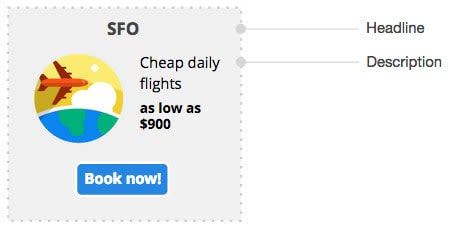Dynamic Price Insertion for Google Display Remarketing for Airlines
- What is Dynamic Display Remarketing for Airlines?
- How Does Dynamic Display Remarketing Work?
- Set up Dynamic Display Remarketing with Prices
- Dynamic Display Remarketing Best Practices
Dynamic Display Remarketing campaigns allow for custom display ads to be shown to people who have previously searched for a specific flight on an airline’s website. These ads appear on relevant Google Display Network (“GDN”) websites and include the route and the price of the specific flight previously searched in the booking engine.
With a message that is tailored specifically to the user, dynamic remarketing enables airlines to reach visitors that have abandoned their flight booking intention.
Here is a generic example by Google:

We created the capability to update fares in display ad copy, in real-time. The FareNetTM script, a proprietary snippet of code, is implemented on the Flights Results page in the airline booking engine.
Then, all prices seen by the user are captured in a database along with the site edition and relevant currency. Through airWire, the cheapest prices get sent in real-time to the AdWords business feeds that allow for inserting prices dynamically in the ad copy using ad customizers.
Currently, we can build multiple business feeds at once regardless of the language/ market combination.
Goals
Our goals in building dynamic price insertion in Display ad copy are:
- Generate the necessary assets (campaigns and business feeds) to launch Dynamic Display Remarketing campaigns.
- Prices are updated in real time for each route
How Does Dynamic Display Remarketing Work? The User Path
Step 1: Cookies
A special tracking code will place cookies in the browser of people visiting the airline website to serve targeted ads on GDN to those with that cookie.
Google AdWords will receive the location, language of browser settings, and route searched when a user abandons the booking process (e.g. Flight results page).
Step 2: Business Feed
Google AdWords matches the relevant business feed and campaign based on location and language and finds the corresponding route and price in the feed.
The price in the business feed comes from airWire, based on business logic agreed upon by each client (e.g. the lowest fare found by users in the next 90 days). Therefore, the price displayed won’t necessarily be the price that the user found while performing his/her original search – it may actually be cheaper.
Step 3: Ad Creation
The ad is created dynamically, based on the information recorded with the cookie.
Ads can be displayed on any device if Google identifies that users are – or have been – logged in with their Google account at some point during the cookie window period.
How to Set up for Dynamic Display Remarketing with Prices
Step 1: Remarketing Tag
Add the dynamic remarketing tag to all pages of the site where the origin and destination airport code can be captured to every search that did not turn into a conversion. Pass dynamic values to the remarketing tag.
- Each step of the booking engine
- Route / Destination pages
- Offer Pages
Best Practice: Implement the AdWords MCC Remarketing tag through Google Tag Manager (GTM).
Dynamic Values
[wpsm_comparison_table id=”9″ class=””]
*Required
**Optional
Reference Google AdWords support article for more information.
Remarketing lists are created based on users captured by the tag.
These lists group users according to certain criteria that include membership duration (how much time has passed since the visited the site) and pages the user visited (e.g. step in the booking funnel in which they abandoned the booking process). The audience list segmentation, for example, could look like:
Membership duration
- 1-3 days
- 4-30 days
- 30-90 days
Steps in the booking funnel
- Flight Results
- Itinerary
- Passenger Details
- Payment
Segmenting users in terms of time frame and steps of the booking funnel, allows for optimizations and bidding to be performed at a more granular level.
Step 2: Account and Campaign set up
Account: One dedicated account for Dynamic Display Remarketing campaigns
Campaigns: Each campaign is geo-targeted to a specific geography and language.
Linking of the campaigns with the corresponding business feed needs to be done manually in the Settings tab of the AdWords interface.
Step 3: Business Feed
Automatically create a business feed for each language and market via the AdWords API that includes all routes with their prices and relevant currency that a user can book on the website. The prices are automatically updated in real-time via airWire.
The logic of the price displayed can be customized, e.g. show the lowest price in the next 90 days.
Note: AdWords limits allow for each account to hold 100 feeds, with 5,000,000 feed items each.
- Currency setting: This setting determines whether the currencies displayed in the ad copy is based on point of origin or point of sale
- Point of Origin: to be used by airlines advertising prices based on where the searched flight is departing from.
- Example: User based in the United States searching for a flight from Mexico City to Rio de Janeiro will see ads in MXN pesos.
- Point of Origin: to be used by airlines advertising prices based on where the searched flight is departing from.
- Point of Sale: is to be chosen by airlines advertising prices in the currency from where the user is searching for a flight.
- Example: User based in the United States searching for a flight from Mexico City to Rio de Janeiro will see ads in USD Dollars.
Step 4: Dynamic Ads
Ads are created and updated dynamically based on the user’s previous search.
Ads are populated with the information in the feed and displayed to the corresponding user across the GDN.
Headline: The character limit for headlines is 25 characters. Ideally, the headline includes the route, otherwise at least the destination:
- Long headline: {origin} to {destination}
- Example: Mexico City to Rio de Janeiro
- Short headline: to {destination}
- Example: To Rio de Janeiro
Landing Page: Specify the landing page to direct the ads. Preferably the ad copy deeplinks to the booking engine, a relevant route or destination page, or the home page.
Image URLs: Create a database containing all the destinations in the route network and their image URLs to be used to create the Business Feeds. Consequently, updates would only be necessary when the airline adds a new destination.
Best Practices
Avoid Showing Non-Competitive Prices
Setting a ceiling price per currency (USD, MXN, COP and BRL) will make sure only competitive prices are displayed in the ads. Whenever a route’s lowest fare is above this ceiling price, the user who searched for this route will not get a remarketing ad.
Create Different Audiences and Optimize Based on Performance
When launching dynamic remarketing campaigns, the strategy is to target all users within the remarketing lists to cover more impressions and increase the probability of conversion. After a test period, implement audience bid modifiers to maximize performance.
Implement Correct Google Tag Manager (“GTM”) Tracking
After you have obtained the required data, create a data layer or custom event with a Dynamic Remarketing structure. Then, create a Dynamic Remarketing Tag in GTM that collects dynamic variables.
